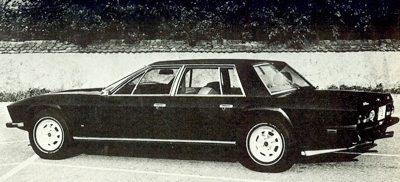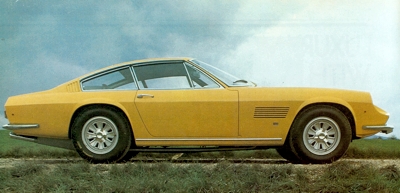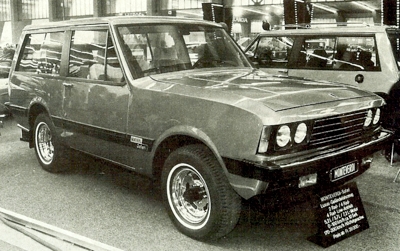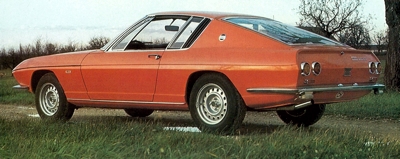Switzerland was never a large manufacturer of cars. However, in 1967, a Basle garage owner and former racing driver, Peter Monteverdi, decided to build a fast two-seater GT car. Monteverdi had constructed his own racing cars, known as MBMs, but he retired after a serious crash and concentrated on his booming BMW sales outlet.
He had often wanted to build his own car and, in 1967, he decided to take the plunge. To make the operation economical, he used a large number of bought-out components so that he needed little factory space; in fact, the cars were assembled in his BMW workshops by the mechanics, in between servicing the BMWs.
The Monteverdi 375S
The basic design of the new car, known as the 375S, was drawn up by Monteverdi himself, but his only major job was to design the chassis on which to hang all the bought-out components. This chassis was a massive creation in square-section steel tubing with built up superstructures to take the front and rear suspension.
This was built by an outside contractor in Basle, as were the double front wishbones which were manufactured from sheet steel. Coil spring/damper units were used at the front and at the rear, the rear suspension also utilising a de Dion axle located by a Watt linkage and parallel trailing arms. Steering was the German ZF power-assisted cam-and-peg layout and braking was by 12 inch outboard front discs and 11.8 in inboard rear discs from Girling.
The engine chosen for the 375S was the 7.2-liter Chrysler V8, mated to the Torqueflite three-speed automatic transmission, with the rest of the drive train coming from Britain's Hardy Spicer. In standard form, this engine gave 375 bhp, but a 400 bhp version was also available and the model fitted with this engine was known as 400SS.
The attractive bodywork was designed and built by Fissore of Turin, but put on to the chassis in Basle. The car was good for a top speed of over 140 mph and could accelerate to 100 mph from rest in a little more than 21 seconds. The 375S and 400SS were in production for only about a year before they were joined by the 375L (for long).
The Monteverdi 375L
The 375L was mechanically very similar to the two-seaters, but its wheelbase was increased to allow the fitment of two rear seats. Fissore modified the body to fit the new chassis without altering the lines too much, and the new car found quite a steady demand from wealthy drivers. A small export market was also undertaken and a number of cars were sent to Britain, marketed by the Hexagon Company. Sales continued sufficiently well over the next couple of years to encourage Monteverdi to indulge in his ambition of building a mid-engined car to rival the Lamborghini Miura.
 Monteverdi 375/4 Limousine.
Monteverdi 375/4 Limousine.
 Monteverdi 375S, designed by Fissore.
Monteverdi 375S, designed by Fissore.
 1977 Monteverdi Safari, based on the International Scout. It offered amazing 120 miles per hour preformance.
1977 Monteverdi Safari, based on the International Scout. It offered amazing 120 miles per hour preformance.
 Unfortunately the Monteverdi above never got beyond prototype stage.
Unfortunately the Monteverdi above never got beyond prototype stage. |
The Monteverdi Hai 450SS
The mid-engined Hai (or shark) 450SS was unveiled in 1971 and it immediately attracted attention because of its brutal good looks. Mechanically, the car was very similar to the front-engined car, using a tubular-steel chassis with double-wishbone front suspension and the de Dion rear suspension modified so that the de Dion axle kinked over the transmission. The big Chrysler 'Hemi' engine was mounted in the centre of the car, protruding into the passenger compartment, and was mated to a ZF five-speed gearbox. Four-wheel disc brakes by Ate were fitted as standard and the manual version of the ZF worm-and-roller steering was standardised.
Body by Trevor Fiore
The body, designed by Trevor Fiore and built by Fissore, featured pop-up headlights and a miniscule rear boot. Despite a top speed of around I 60 mph and good handling, the lack of accommodation for both passengers and luggage and a poor gearchange restricted sales to just a few examples and production soon ceased. In 1972, Monteverdi produced two more new models, the 375/4 and the Berlinetta. The 375/4 was a four-door, four-seater GT saloon intended to attack the luxury-saloon market owned almost exclusively by RoIls-Royce and Mercedes. Again, the car was mechanically similar to its forerunners apart from a much longer wheelbase of 10 ft 5 in.
The Monteverdi Berlinetta
With a heavy new body from Fissore, the 375/4 scaled over two tons, but it was still capable of reaching 140 mph and accelerating from 0 to 60mph in 8 seconds with the 7.2-liter Chrysler engine. However, this 17 ft-long machine did not attract much attention from wealthy potential buyers, and was soon dropped. The Berlinetta was a high-performance version of the early 375S two seater. The chassis was again much the same as before, but it was fitted with the high-performance engine from the Hai which was claimed to give 450 bhp. The car was given new styling treatment, and a top speed of 180 mph was claimed for it, but the great weight and modest aerodynamics prevented the car from topping the 160 mph achieved by the Hai.
The Monteverdi Safari
The mainstay of production continued to be the 2 + 2 375L but, as safety and pollution regulations began to bite and fuel prices began to soar, demand for Monteverdi’s slackened, reducing production to a trickle by late 1973. The fuel crisis of 1974-5 almost brought production to a standstill, forcing Peter Monteverdi to concentrate on his thriving BMW distributorship in Basle. Having weathered the storm however, the Monteverdi operation was looking more healthy in 1977 with a new Range Rover 'look-alike' called the Safari (a re-bodied International Trucks Scout) and a 'built to special order' convertible called the Palm Beach to supplement the range.
These models sold in greater numbers than the preceding sports cars and remained in production until 1982. Then between 1980 and 1982 Monteverdi would manufacture their own unique version of the 4 door Range Rover, however despite ambitious plans for subsequent models productionwould cease in 1982, and the factory was converted into a museum, the Monteverdi Car Collection,in 1985.
Also see: Monteverdi Car Reviews